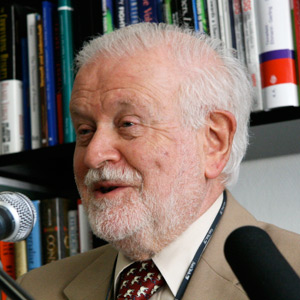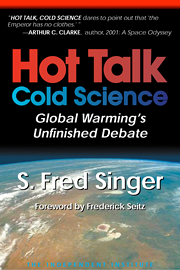I have recently become quite concerned about ice ages and the dangers they pose to humans on our planet—and indeed to most of terrestrial ecology.
I must confess I never much worried about the supposed dangers of global warming—even if we could rely on the predictions of IPCC climate models. In fact, they seem to be failing miserably, as judged by the ongoing pause in GW—while atmospheric levels of anthropogenic CO2 and other greenhouse gases continue to increase. It seems that our climate is mainly controlled by natural forcings, like solar activity and atmosphere-ocean oscillations that are not included in current models.
What drew my attention to ice ages is the manuscript (Climate and Collapse) by agricultural economist Dennis Avery, my coauthor on Unstoppable Global Warming: Every 1500 years [Rowman&Littlefield 2007]. Dennis documents the historic collapse of civilizations, using recorded history and archeological data. Cold periods and droughts appear to be the main dangers to agriculturally based societies in all regions of the world.
There is no question here: To protect our civilization from harm, it is vitally important to understand the causes of severe climate cooling and try to figure out how to prevent such cooling episodes, if possible.
There are two kinds of ice ages; they are fundamentally different and therefore require different methods of mitigation: (i) Major (Milankovich-style) glaciations occur on a 100,000-year time-scale and are controlled astronomically. (ii) “Little” ice ages were discovered in ice cores; they have been occurring on an approx. 1000-1500-yr cycle and are likely controlled by the Sun. The current cycle’s cooling phase may be imminent—hence there may be urgent need for action.
Major glaciations—on a 100,000-year time scale
I recently published an essay on these pages on how to avoid the next major ice age; there have been nearly 20 such glaciations in the past two to three million years. The coolings are quite severe: the most recent one, ending only about 12,000 years ago, covered much of North America and Europe with miles-thick continental ice sheets and led to the disappearance of (barely) surviving bands of Neanderthalers; they were displaced by the more adaptable Homo Sapiens.
According to the Serbian astronomer Milankovich, glaciation timing was controlled by astronomical parameters, such as oscillations, with a 100,000-year period, of the eccentricity of the Earth’s elliptic orbit around the Sun, oscillations with a period of 41,000 years of the Earth’s “obliquity” (inclination of the spin axis to the orbit plane, currently at around 23 degrees), and a precession of this spin axis, with a period of about 21,000 years.
While many consider the timing issue as settled, there are plenty of scientific puzzles still awaiting solutions: For example, how to explain the suddenness of de-glaciation, transiting within only centuries from a glaciation maximum into a warm Interglacial, like the present Holocene period.
Most expect the next glaciation to arrive rather soon; but calculations by Prof Andre Berger of the Catholic University of Louvain, Belgium, suggest a delay of up to 40,000 years—so there may be no great urgency. Nevertheless, it would be useful and of great scientific interest to verify the existence of a hypothesized “trigger” that might be disabled by human action—at low cost and negligible risk.
Little Ice Ages (LIA) and the Dansgaard-Oeschger-Bond (D-O-B) cycles
After digesting hundreds of comments about my essay on stopping the next major ice age, I recognized the need to explain the existence also of “little” ice ages, which are likely of solar origin. They occur quite apart from the major glaciations, have a cycle length of about 1000-1500 years, and demand different methods of mitigation. They were discovered in Greenland ice cores by the Danish researcher Willi Dansgaard and by (Swiss scientist) Hans Oeschger, and further observed in ocean sediments by the late US geologist Gerard Bond [see Unstoppable Global Warming: Every 1500 years]
We don’t know what triggers an LIA, but suspect a strong correlation with a quiet Sun and prolonged absence of sunspots. Experts in this field—Willie Soon (Harvard Observatory), Harjit Ahluwalia (University of New Mexico), Russian astronomer Habibullo Abdussamatov, the Hadley Centre in UK, and many others—believe that the next LIA is imminent. The most recent LIA lasted from 1400 to 1830 AD—off and on. It followed the Medieval Warm Period (MWP), when wine grapes grew in northern England and Norsemen were able to farm in southern Greenland.
The impact of the recent LIA was rather severe. The Norse settlements were abandoned; indeed, Scandinavia was hardest hit. Climatology pioneer Hubert Lamb documents crop failures, starvation, and disease in Europe, together with ice fairs on the frozen Thames. During much of the American Revolution, New York Harbor was frozen over. And we recall paintings of George Washington crossing the Delaware River, impeded by ice floes.
How to overcome an LIA
To avoid the huge human misery and economic damage, one would like to counteract the cooling phase of the D-O-B cycle—but how? The next LIA may be only years away; but there is no obvious trigger for solar influence; our understanding of solar physics is limited by the rather short history of observation of the Sun. While data on sunspots go back centuries, modern observations using spacecraft extend only for years.
An obvious scheme to counter a cooling is to make use of greenhouse (GH) warming. However, carbon dioxide is not the answer: CO2 is limited in supply and is already mostly saturated—hence additional CO2 is not very effective. Synthetics, like SF6, are too long lasting and may have risky side-effects. The best answer may be water, but in the form of ice crystals; the scheme is easily tested and is transitory—reversible and incurring little risk.
For a specific technical proposal see Saving Humanity from Catastrophic Global Cooling: A Task for Geo-Engineering:
Here is how I picture the operation—starting with a small feasibility test and validation of the theory:
A typical aerial-refueling aircraft can carry ~100 tons of water, which is to be injected as mist at the tropopause, at the bottom of the stratosphere, near an atmospheric temperature minimum. To start, one might choose a surface density of water mist of 0.1 kg/m2, the area covered would be ~1km2.
Like contrails from aircraft, I expect some visible cirrus, which should disappear rapidly. It would leave behind longer-lasting invisible cirrus, made up of ice crystals that are strong absorbers/emitters of infrared (IR) radiation, which covers also the atmospheric “IR-window” region of 8 to 12 microns—thus creating a major GH effect, and possibly even some detectable warming at the Earth’s surface. Any satellite-borne IR-instrument should be able to track this emitter patch, measure its radiative climate forcing, and follow its spread and decay—whether days or months.
However, all this is based on theory and on calculations, which I published in 1988 in the peer-reviewed journal Meteorology and Atmospheric Physics. Obviously, such predictions must be validated by direct observations. Once the scheme is scientifically verified, operational planning for countering a possible cooling can take over.
As usual, there are many scientific questions that require answers—chiefly, understanding the physical mechanism that drives the D-O-B cycles; how to explain the size, shape, and duration of the abrupt quasi-periodic warmings and coolings. Currently, there is a hot dispute about the synchronicity of the cycles between the two Polar Regions, revolving about the limited accuracy of ice-layer dating in Antarctic ice-cores.
While the science is certainly interesting and important, there is really no need to delay the crucial and urgent tests of geo-engineering, designed to validate a GH scheme of mitigation. Such tests involve only minor costs and present negligible risk to the atmospheric environment.









